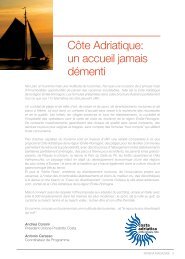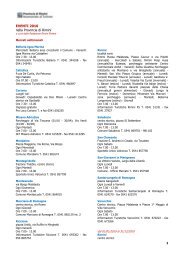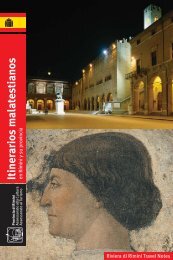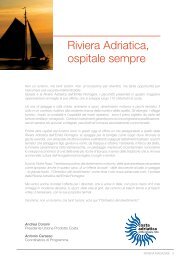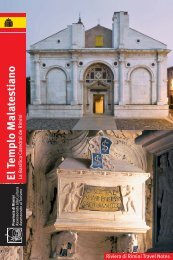Malatesta fortresses and castles
Malatesta fortresses and castles
Malatesta fortresses and castles
- No tags were found...
Create successful ePaper yourself
Turn your PDF publications into a flip-book with our unique Google optimized e-Paper software.
GradaraFortresspiazza Alberta Porta Nataletel. 0541 964181-964115fax 0541 823035www.gradara.orginfo@gradara.org• open all yearAbove: view of Montefiorevillage <strong>and</strong> the parish church,from the Fortress. Below,Gradara Fortress.36with a beautiful stone coat of arms complete with a crest, still inexistence, <strong>and</strong> with paintings still surviving, miraculously, in part.In the great “Chamber of the Emperor” (near which were to befound also a “Throne Room” <strong>and</strong> a “Hall of the Pope”) can be seena number of “portraits” of ancient heroes, <strong>and</strong> two fragmentarybattle scenes, frescos painted by Jacopo Avanzi in about 1370.These are the only surviving remains of decorative painting inprivate <strong>Malatesta</strong> family constructions. Frescos <strong>and</strong> paintings aredocumented in many other <strong>Malatesta</strong> <strong>castles</strong> <strong>and</strong> residences: inPesaro, Montelevecchie, San Costanzo di Fano, Brescia, Rimini,Gradara; but no trace remains of any of these. Before leavingMontefiore, notice the buildings which make a semicircle at the feetof the castle, <strong>and</strong> the parish church with a fine Gothic doorway <strong>and</strong>a Crucifix of the thirteenth-century Rimini school. Walled on thegateway to the village, to which was added a drawbridge in theMiddle Ages, is a stone tablet with the coats of arms of PopePiccolomini, Pius II, <strong>and</strong> of the Cardinal Legate Niccolò Forteguerri.This, the work of one Giacomo, a stone-cutter from Ferrara, wasplaced here in 1464 after the defeat of Sigismondo <strong>Malatesta</strong>, inplace of a <strong>Malatesta</strong> coat of arms.Gradara is another mighty fortress which served both as adefence <strong>and</strong> a sumptuous residence. Like Montefiore, it was anallodial possession of the <strong>Malatesta</strong> family – that is to say, aproperty bought by them, not held as a Papal concession. Toappreciate its defensive significance, it should be viewed inconnection with Rimini <strong>and</strong> as part of a system which included the<strong>fortresses</strong> of Gabicce, Casteldimezzo <strong>and</strong> Fiorenzuola on the cliffsalong the coast, <strong>and</strong> Tavullia inl<strong>and</strong>. In 1364 <strong>Malatesta</strong>“Guastafamiglia” willed Montefiore <strong>and</strong> Gradara respectively tohis sons <strong>Malatesta</strong> Ungaro <strong>and</strong> P<strong>and</strong>olfo. P<strong>and</strong>olfo was a friend ofthe poet Petrarch <strong>and</strong> the father of <strong>Malatesta</strong> “of the sonnets”who died in Gradara castle in 1429. He is known to have beeninterested in painting as well as in poetry; he sent a painter toPetrarch to take his portrait secretly <strong>and</strong> recruited artists fromFlorence (among whom was the young Lorenzo Ghiberti) todecorate his residence in Pesaro. In all probability, the frescosdepicting heroes <strong>and</strong> battles of antiquity which documentaryevidence shows were painted both in Gradara castle <strong>and</strong> in thePesaro residence, were commissioned mainly by P<strong>and</strong>olfo, <strong>and</strong>were perhaps not so different from those commissioned by Ungarofor Montefiore.In the fortress of Gradara there are still fifteenth-century






